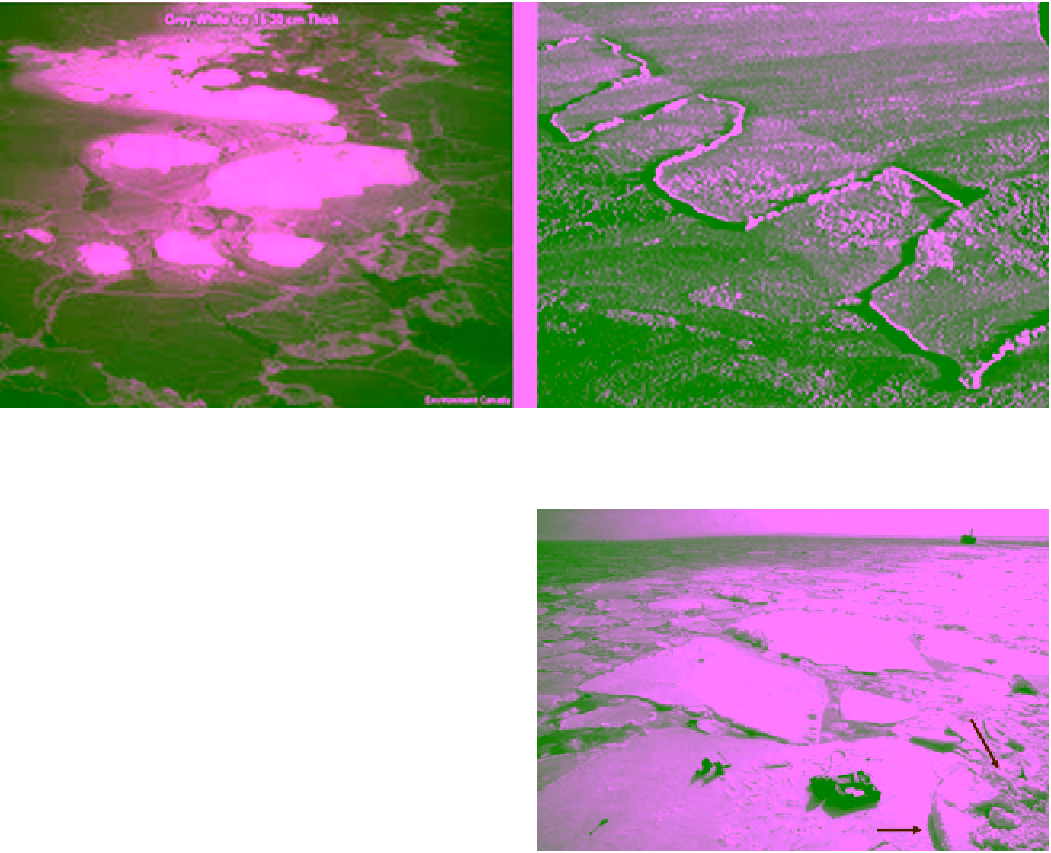Geology Reference
In-Depth Information
(a)
(b)
Figure 2.42
(a) Simple rafting at the bottom right corner of the ice cover in the Arctic (from CIS archive), and (b)
finger rafting in the Antarctica. (from
Vella and Wettlaufer
, 2007).
forming finger‐like interlacing edges (Figure 2.42b).
Actually, simple rafting, more often than not, also involve
finger rafting, as can be seen in both Figures 2.9 and
2.42a. Finger rafting occurs when both sheets are ≤15 cm
thick [
Weeks and Kovacs
, 1970;
Vella and Wettlaufer
,
2007]. In an early publication that addressed thin freshwa-
ter ice in Lake Superior,
Green
[1970] found that most fin-
gers range from 0.5 to 3 m wide and from 2 to 10 m long.
This author also observed that narrowest fingers (30-
100 mm) occurred in extremely thin and fragile ice
(2-3 mm thick), whereas the wider ones (up to 10 m)
occurred in ice between 10 and 20 mm thick. The fingers
shoved forward by traction from a light breeze at a rate
ranging from about 5 to 50 mm/s. Another rafting situa-
tion, yet resulting from thicker ice, can be seen at the bot-
tom right corner of the photograph in Figure 2.43 where
the edge of the rafted floe is visibly bent. Bending stress
associated with such thick floe usually results in fractur-
ing the floe. A noticeable feature in the photograph is the
piling of fractured ice from the weaker floe when collided
with the stronger floe that survived the crash.
Modeling of thin ice rafting is not frequently presented
in the literature. A one‐dimensional thermal consolidation
model for rafted sea ice is presented in
Bailey et al
. [2010].
The rafted ice usually comprises layers of equal thickness
separated by thin layers of ocean waters. Using parame-
ters representative of ice in the Caspian Sea, the Arctic,
and the Antarctic, the authors concluded that it took 15 h
for two layers of rafted sea ice to consolidate, but the con-
solidation is sensitive to the initial thickness of the liquid
layer and the fraction of salt release during freezing.
Ridging is a major form of ice deformation that results
from collision of ice sheets of at least tens of centimeter
Remnant of a
broken floe
Rafting
Figure 2.43
A variety of ice floe sizes and broken ice pieces in
the Labrador Sea. Note the rafting of two relatively thick ice
pieces at the bottom right corner of the picture and the conse-
quent ice bending and fracturing (the photograph was taken by
N. K. Sinha from the deck of an icebreaker).
thick. It is created by the flexural failure of the edges of the
two sheets, forming broken blocks that accumulate usually
on top of the thicker ice (developing the sail) and beneath
the ice (developing the keel) as shown in Figure 2.44.
On mobile ice floes, the ridges are formed normal to the
direction of the prevailing wind and/or current, but even-
tually the ridges may act as sails and turns the floes to
become parallel to direction of wind. Ridges are different
than the raised edges of relatively thin ice floes when they
collide as shown in Figure 2.45 (finger rafting appears
also at the top of the photograph). Raised edges are lim-
ited in width, but the ridging process continues as long as
the impinging process of the ice sheets ice continues.

